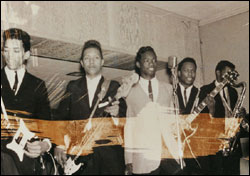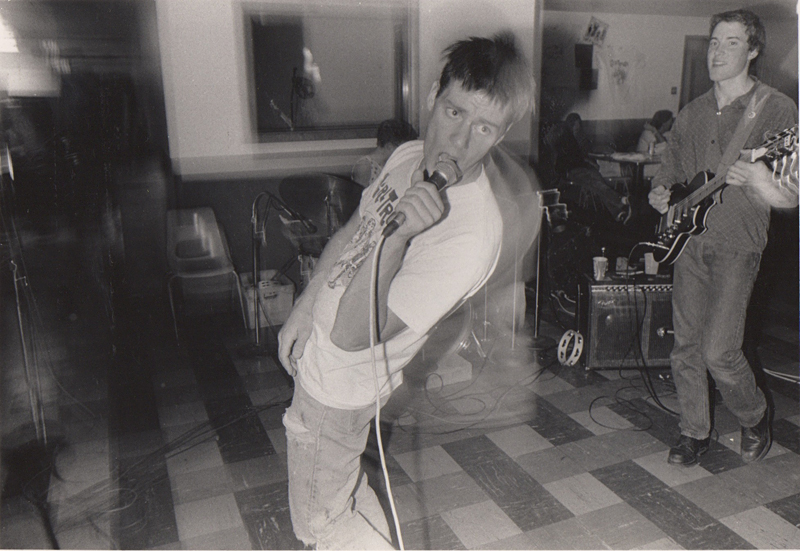In the spring of 1960, a Garfield High School teacher named Edward Deligan walked through the Seattle Art Museum to take in a citywide exhibition of student art. Deligan recognized one name on the wall from his school, and liking the painting and knowing the student needed the money, he plunked down $5 and bought it. For three decades, “Memories of Hawaii” hung in Deligan’s daughter’s room.
It now hangs in Experience Music Project’s expanded Hendrix gallery as one of the shining examples of the fact that Jimi Hendrix was multitalented. While it’s not “Purple Haze,” the watercolor shows promise for a 16-year-old; the painting is also a bit eerie in that Hendrix hadn’t been to Hawaii when he painted the scene, and the state would be the setting11 short years laterfor his last U.S. concert before his death at 27.
The expanded Hendrix gallery now serves as the museum’s centerpiece and finally gives due to the man who is, in effect, EMP’s namesake. The new exhibit space is on the second floor and is three times as big as the previous Hendrix room. The additional span allows the curators to stretch out and give more attention to Hendrix’s Seattle youth and his time in R&B bands pre-fame. There’s even a wall that displays early Hendrix family history, including a letter from 8-year-old Jimi to his grandmother, which he signs off as “tweet, tweet, Buster,” his nickname at the time.
Though much of the early memorabilia shows Hendrix to be a remarkably normal youthhe drew cartoons and pictures of race carsthe fact that these childhood treasures still exist is testament to father Al Hendrix’s pack-rat tendencies: Neither he, nor anyone else, knew Hendrix was destined for superstardom when he began storing away Jimi’s drawings of soldiers fighting Native Americans (and, as you’d expect, owning to Jimi’s Cherokee ancestry, the Indians outnumber the soldiers 10 to one). As co-curator Jim Fricke said at the event’s opening party, “I’m honored to play a role in uniting Paul Allen’s dream with all the stuff Al Hendrix saved.”
Certainly the most significant development of the new gallery is that for the first time in years, EMP and Experience Hendrix are working together on this exhibit. While that union seems logical to most, it comes after almost a decade of behind-the-scenes battles between the two entities. Allen initially wanted to name EMP “The Jimi Hendrix Museum,” and though he loaned Al Hendrix several million dollars to help in Al’s legal battle over his son’s estate, that largesse dried up when naming rights were not granted. Allen’s loan became due, and the Hendrix family was forced to settle their lawsuit rather than continue to fight it. Those wounds weren’t discussed at the opening of the new exhibit. When museum director Bob Santelli announced, “Finally, we unite the experience and the collections of Experience Hendrix and EMP,” the peace was clearly on.
THANKFULLY, the new exhibit doesn’t overglamorize Hendrix. Instead it humanizes him. “Our goal is to tell the back story,” says Jacob McMurray, co-curator of the exhibit, “that part of Jimi that isn’t rock god because, frankly, that has been done enough.” There is, however, one solid slice of godliness: Hendrix’s velvet suit from his appearance at the Isle of Wight, his last significant show before his untimely death. How a man as big as Hendrix jammed into this elfin costume boggles the mind, but there is some evidence if one gets down and looks closely at the crotch: Hendrix broke the seams in the pants onstage.
Also in the same case, and not particularly well displayed, is another small item that illustrates why the new gallery will appeal to an audience that wants a glimpse into the man, rather than the rock god. There sits Hendrix’s handwritten instructions to then-girlfriend Kirsten Nefer on how to get to the Isle of Wight. “Ferrie to Isle,” he notes. Written by a kid who spent two-thirds of his short life listening to ferry traffic on Puget Sound, the misspelling is both a sign of pure humanness and another small crack in the facade of the guitar god.
Charles R. Cross’ biography of Jimi Hendrix is due out in late 2004.








